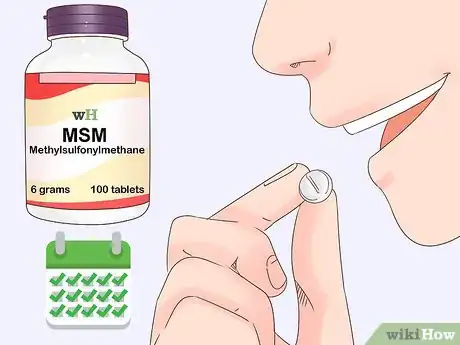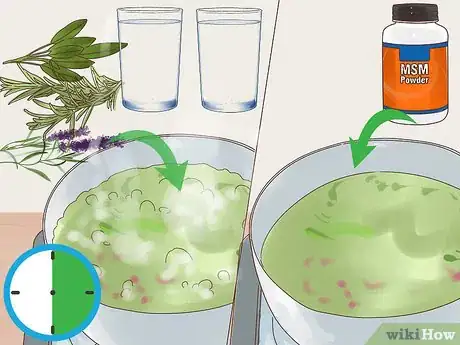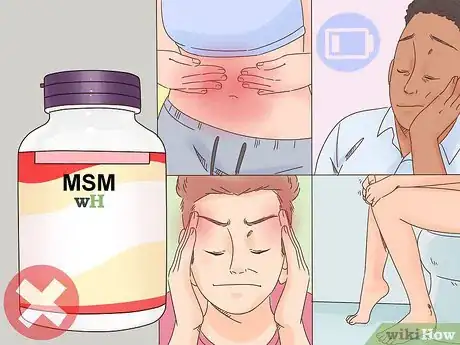This article was medically reviewed by Sarah Gehrke, RN, MS. Sarah Gehrke is a Registered Nurse and Licensed Massage Therapist in Texas. Sarah has over 10 years of experience teaching and practicing phlebotomy and intravenous (IV) therapy using physical, psychological, and emotional support. She received her Massage Therapist License from the Amarillo Massage Therapy Institute in 2008 and a M.S. in Nursing from the University of Phoenix in 2013.
There are 10 references cited in this article, which can be found at the bottom of the page.
This article has been viewed 66,620 times.
Methylsulfonylmethane (MSM) is a popular dietary supplement used for a range of purposes. While it's most often taken for joint pain, it might help promote healthy hair growth. Keep in mind there's little scientific evidence of its health benefits. If you want to give it a try, take an oral or topical supplement daily. Aside from supplements, you can eat more foods that contain MSM and other beneficial sulfuric compounds, such as fish, kale, and onions. As with any dietary supplement, consult your doctor before taking MSM, and ask them to recommend a dosage.
Steps
Taking MSM Supplements
-
1Take up to 6 grams per day of MSM in tablet form. While the recommended daily dosage is up to 6 grams, divided into 3 doses, start at a lower dose and see how it affects you. Try taking a 1-gram tablet 3 times a day, and increase your dosage over the course of 1 to 2 weeks. To prevent an upset stomach, take each dose with a glass of water and a meal.[1]
- MSM is available in tablet, powder, and liquid forms online, at pharmacies, and at health stores. It's most often used for arthritis and muscle pain, so check your store's joint health section.
- Those who use MSM and report positive results say that it takes at least 2 weeks to notice effects.
-
2Mix powdered MSM with water if you don't like taking pills. Go with the oral dosage form that you're most comfortable taking regularly. If you can't or don't want to swallow pills 3 times a day, use the powdered form. Check your product's instructions for specific information about how much powder and water you should mix together.[2]Advertisement
-
3Try a 5 to 10% MSM shampoo or cream instead of taking it orally. Oral supplements are more popular and more readily available, but you can also try using a topical product. Daily use of an MSM solution at concentrations between 5 and 10% might help hair loss. Read your product's instructions and use it as directed.[3]
- The study showed positive results within 20 days of beginning treatment.
-
4Make your own MSM shampoo if you can't find a product. If you can't find a store-bought MSM shampoo or cream, or if you don't want to splurge on one, making your own is relatively easy. Bring 2 cups (470 mL) of distilled water to a boil, then add 1⁄2 ounce (14 g) each of rosemary, sage, nettles, and lavender. Remove the mixture from the heat and let it cool for 30 minutes.[4]
- After 30 minutes, add 2 grams of powdered MSM. Let the mixture sit for 30 to 40 minutes, then strain it into a bowl.
- After straining it, combine 1 part of the herbal mixture with 2 parts of liquid castile soap in a plastic bottle, such as an empty shampoo bottle. For instance, combine 4 fluid ounces (120 mL) of the herbal mixture with 8 fluid ounces (240 mL) of castile soap.
- Most stores that sell shampoo and bath products carry castile soap.
-
5Store MSM supplements in a cool, dry place after opening. MSM products don't need to be refrigerated. A medicine cabinet, pantry, or drawer will do just fine. You should use the MSM by the expiration date printed on the label.[5]
Eating Foods that Contain MSM
-
1Eat plenty of protein-rich foods. MSM is found in protein sources including eggs, fish, poultry, and legumes.[6] Most health organizations recommend eating 0.8 grams of protein per kilogram you weigh, or about a third as many grams as your weight in pounds.[7]
- For example, if you weigh 140 pounds (64 kg), your recommended protein intake is 53 grams per day. A 3 ounce (85 g) serving of tuna, salmon, or trout counts as 21 grams of protein. A 3 ounce (85 g) serving of poultry counts as 19 grams of protein, and 1 egg counts as 6 grams.
- The healthiest way to add extra protein to your diet is to eat more legumes, such as beans or peanuts. Additionally, go for lean cuts of fish and poultry instead of fattier red meats.
-
2Go for garlic and onions. While garlic and onion contain MSM and other sulfuric compounds, they're most often consumed cooked instead of raw. Since MSM breaks down during the cooking process, try adding raw onion and garlic to salads and dressings.[8]
-
3Add more Brussels sprouts, cabbage, and kale to your diet. Fruits and veggies are, in general, good sources of sulfuric compounds such as MSM. Leafy greens and cruciferous vegetables (such as cabbage) are especially good choices.[9]
- Leafy green and other fruits and vegetables also contain vitamins and minerals that promote healthy hair, skin, and nails.
-
4Eat foods that contain MSM raw, if possible. Cooking breaks down MSM, so you don't get as much from cooked foods as raw foods. While cooked foods still provide MSM and other beneficial sulfuric compounds, try to eat MSM sources raw if there's no risk of foodborne illness.[10]
- For example, snack on unsalted peanuts or have kale salads with chopped onions and grated garlic.
Using MSM Products Safely
-
1Talk to your doctor before taking any dietary supplement. MSM is not associated with any health risks, drug interactions, or side effects. However, you should still ask your doctor if taking an MSM supplement is right for you. They might recommend other treatment options or test for underlying conditions if you're experiencing premature or unusual hair loss.[11]
- Additionally, there's little scientific evidence that MSM promotes hair growth or improves hair loss.
-
2Lower your dose or stop taking MSM if you experience side effects. While there's no scientific evidence that MSM causes side effects, some people report stomach pain, diarrhea, headache, and fatigue.[12]
- Stop taking MSM and seek medical attention if you experience signs of an allergic reaction, such as skin rash, trouble breathing, or swelling.
-
3Don't take MSM if you're pregnant or breastfeeding. Medical professionals aren't sure if MSM can affect pregnancy or pass to an infant through breast milk. Even if there's no known harmful effects, you should still avoid taking it if you are pregnant, plan on becoming pregnant, or are breastfeeding.[13]
References
- ↑ https://www.drugs.com/npp/methylsulfonylmethane-msm.html
- ↑ https://draxe.com/msm-supplement/
- ↑ https://www.researchgate.net/publication/247915887_The_Effect_of_Methylsulfonylmethane_on_Hair_Growth_Promotion_of_Magnesium_Ascorbyl_Phosphate_for_the_Treatment_of_Alopecia
- ↑ https://www.earthsfriends.com/how-to-make-natural-shampoo/
- ↑ https://www.nowfoods.com/supplements/msm-powder
- ↑ http://healthyeating.sfgate.com/major-sources-dietary-sulfur-4924.html
- ↑ https://www.health.harvard.edu/blog/how-much-protein-do-you-need-every-day-201506188096
- ↑ https://draxe.com/msm-supplement/
- ↑ http://healthyeating.sfgate.com/major-sources-dietary-sulfur-4924.html
About This Article
Although there’s no scientific evidence to back this up, some people take the dietary supplement MSM to help hair growth. To take MSM safely, take 3 doses a day with water or a meal to prevent an upset stomach. The recommended dosage is 6 grams per day, so each dose should be no more than 2 grams. People report that MSM takes about 2 weeks to have a visible impact on your hair growth. If you don’t like taking MSM orally, you can also apply an MSM cream or use an MSM shampoo. MSM is also found in protein-rich foods like eggs, fish, and legumes, so try to include these items in your diet. Other food options include adding raw onions and garlic to salads, and eating more kale and cabbage. If you experience any side effects, like diarrhea, sore head, or stomach pain, reduce your MSM dosage or stop taking it altogether. For tips from our Medical co-author on how to store MSM tablets after you’ve opened them, read on!






































































